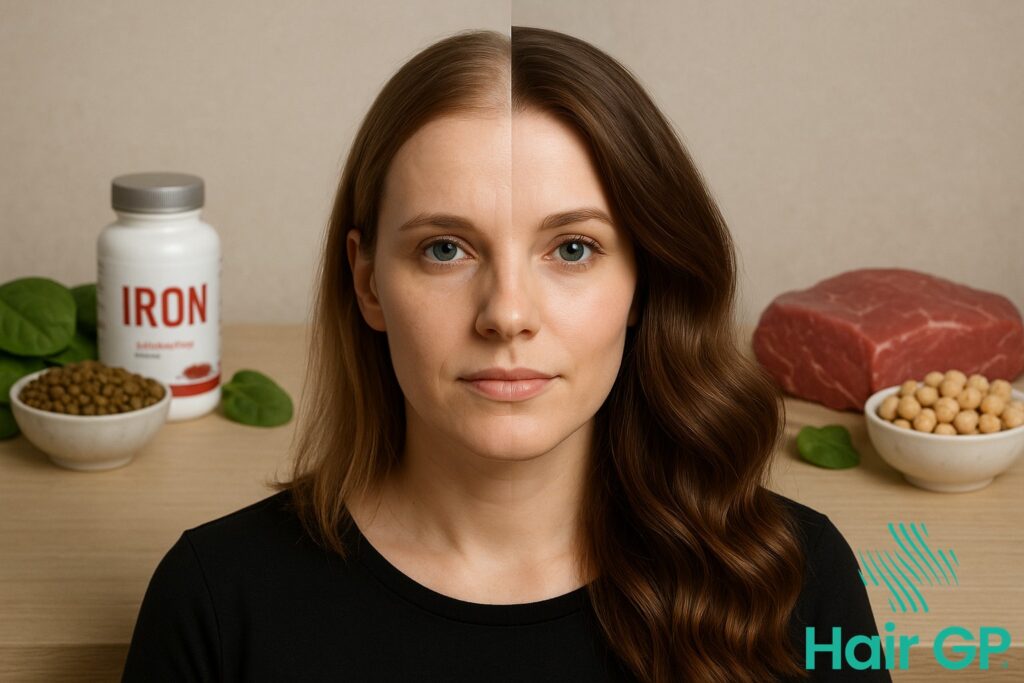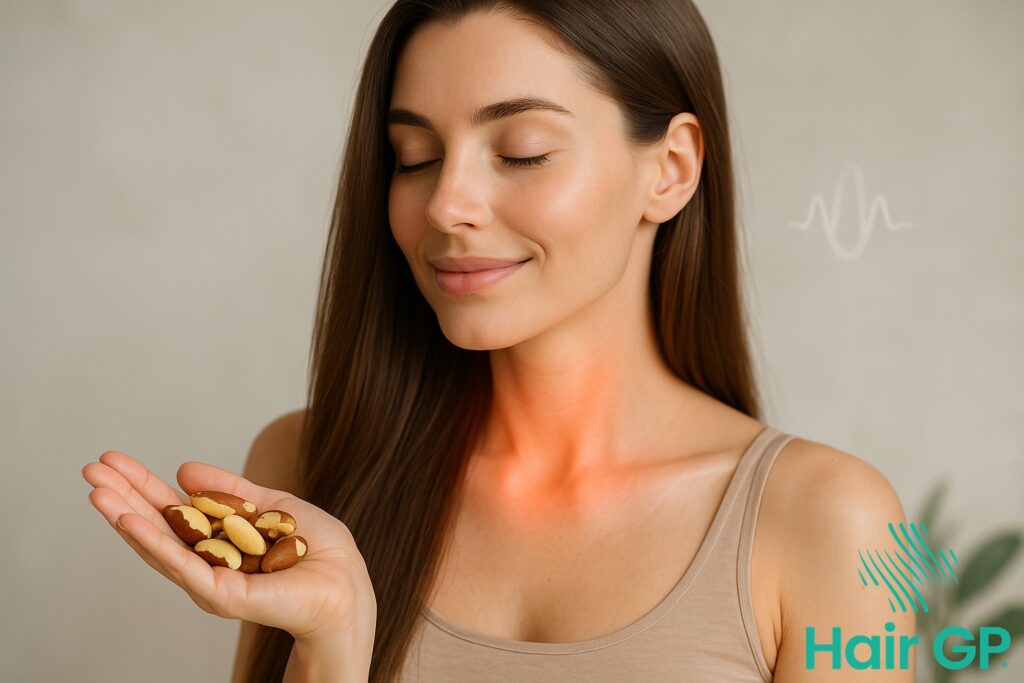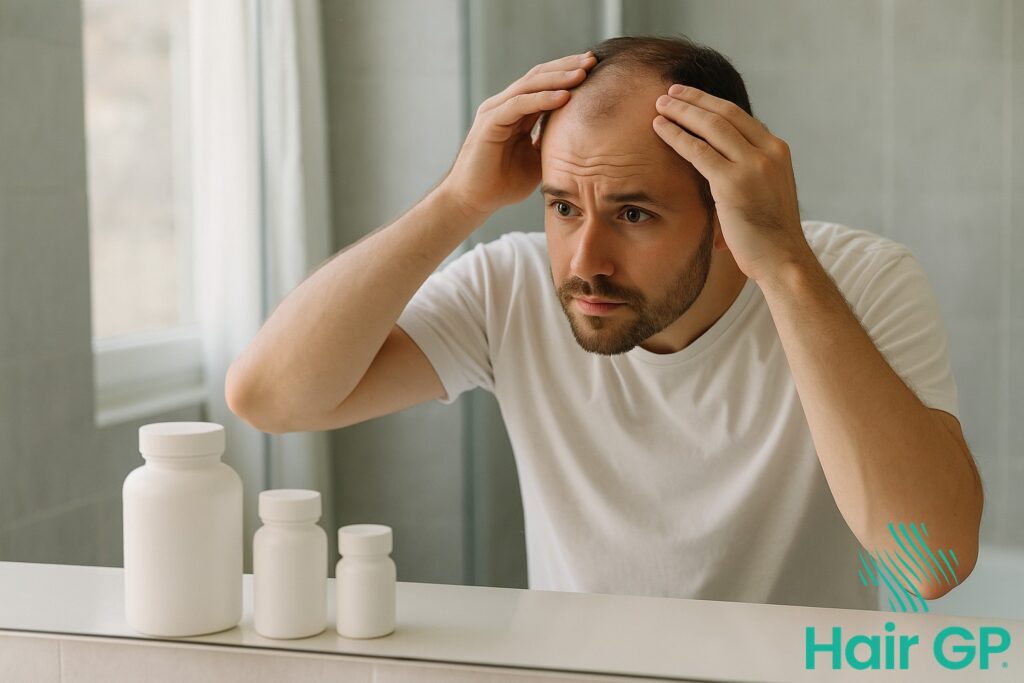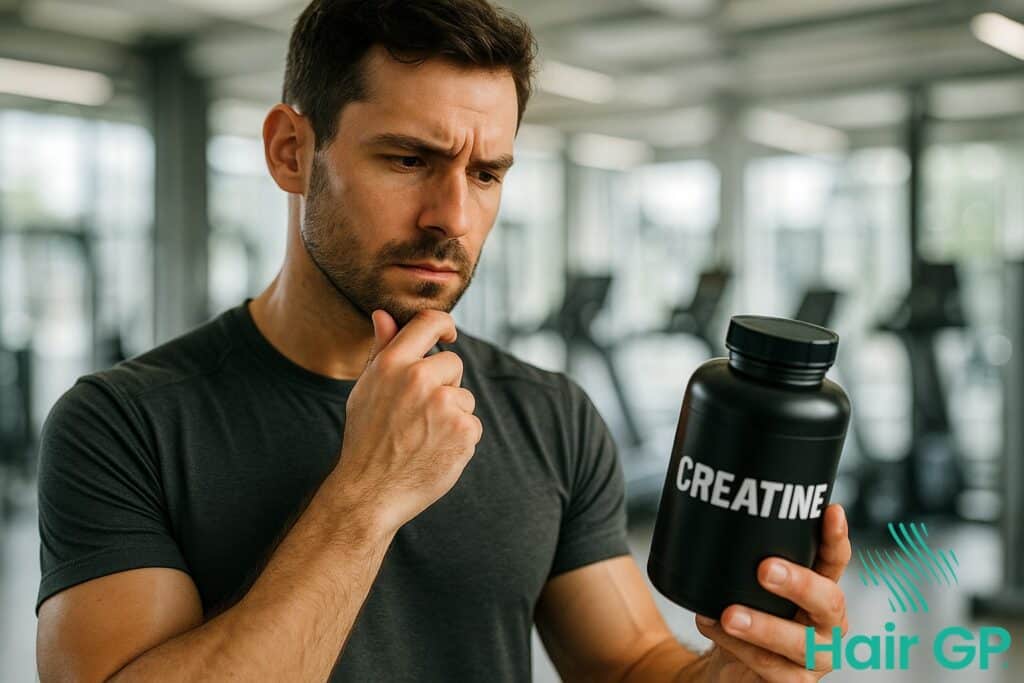Introduction
If you’re experiencing hair loss and suspect iron deficiency might be the culprit, you’re not alone. Millions of people, particularly women, struggle with hair falling out due to low iron levels. But here’s what many don’t realise: simply popping an iron supplement might not be enough to restore your hair health.
The connection between being iron deficient and experiencing hair loss is well-established in medical literature. Iron plays a crucial role in producing haemoglobin, which carries oxygen to your hair follicles. Without adequate iron, your hair growth cycle can be severely disrupted, leading to increased shedding and slower regrowth. Yet despite taking supplements religiously, many people continue to see their hair thinning.
Why? Because there’s a significant difference between taking iron and actually absorbing it. Your body’s ability to utilise iron depends on numerous factors, from when you take your supplements to what you eat alongside them. Small mistakes in supplementation can reduce absorption by up to 80%, rendering your efforts virtually useless.
This article will explore the science behind how iron deficiency affects your hair growth cycle, help you recognise signs that you’re not absorbing iron properly, and identify common supplementation mistakes. You’ll discover what constitutes optimal iron levels for hair health (hint: it’s higher than standard ‘normal’ ranges) and learn practical strategies to maximise iron absorption for faster hair recovery. Understanding these crucial details could be the difference between continued hair loss and finally achieving the healthy, full hair you desire.
Key Takeaways – TL/DR
- Iron deficiency is a leading cause of hair loss, but many people take supplements incorrectly, reducing absorption by up to 80%
- Your ferritin levels should be above 70 ng/mL for optimal hair growth, not just within the normal range
- Taking iron with vitamin C increases absorption while calcium, coffee, and tea can block it
- Hair regrowth from corrected iron deficiency typically takes 3-6 months to become noticeable
The Science Behind Iron Deficiency and Hair Loss
Understanding how hair loss iron deficiency develops requires examining the intricate relationship between iron metabolism and the hair growth cycle. Your hair follicles are among the most metabolically active tissues in your body, requiring adequate iron stores to maintain their rapid cell division and growth patterns.
Iron plays a pivotal role in multiple cellular processes essential for healthy hair growth. Within the hair follicles, iron serves as a cofactor for ribonucleotide reductase, an enzyme crucial for DNA synthesis during the proliferative anagen phase. When iron levels drop, this enzyme cannot function optimally, disrupting the normal growth cycle and pushing more follicles prematurely into the resting phase[1].
Ferritin, the storage form of iron, serves as a critical biomarker for assessing iron stores in relation to hair health. Research demonstrates that low ferritin levels, even without iron deficiency anemia, can trigger significant hair shedding. Studies suggest that maintaining ferritin levels above 70 ng/mL may be necessary for optimal hair growth, considerably higher than the threshold for preventing anaemia[2].
When iron stores become depleted, the body prioritises essential functions like oxygen transport over hair growth. This biological triage leads to telogen effluvium, a condition where numerous hair follicles simultaneously enter the resting phase and subsequently shed. Unlike pattern baldness, telogen effluvium caused by iron deficiency typically results in diffuse thinning across the scalp rather than localised hair loss.
The impact extends beyond simple nutrient deficiency. Iron depletion affects the hair matrix cells’ ability to proliferate and differentiate properly, weakening the hair shaft structure itself. This can manifest as brittle, dull hair that breaks easily, compounding the appearance of thinning even before significant shedding occurs.

Signs You’re Not Absorbing Iron Properly
Even when diligently taking iron supplements, many people continue experiencing hair loss and other symptoms of low iron levels. This frustrating situation often points to an absorption problem rather than insufficient intake. Recognising the signs of poor iron absorption can help you understand why your supplementation efforts might not be yielding the expected results.
The most telling indicator is persistent fatigue that doesn’t improve despite weeks of supplementation. If you’re still feeling exhausted and noticing ongoing hair thinning after taking iron tablets for several weeks, your body likely isn’t absorbing the mineral effectively. Other physical symptoms include brittle nails, pale skin, shortness of breath, and cold hands and feet that persist despite treatment.
Blood tests provide crucial insights into absorption issues. While your serum iron might show temporary spikes after taking supplements, your ferritin levels – which reflect stored iron – may remain stubbornly low. This discrepancy between serum iron and ferritin levels is a classic sign of absorption problems. Additionally, if your anaemia markers haven’t improved after appropriate supplementation periods, it strongly suggests malabsorption.
Digestive symptoms often accompany poor iron absorption. Bloating, constipation, or stomach upset after taking supplements can indicate that your digestive system is struggling to process the iron. Some people also report a metallic taste that lingers long after taking their supplement, suggesting the iron isn’t being properly absorbed and utilised by the body, leaving excess amounts in the mouth and digestive tract.

Common Mistakes When Taking Iron Supplements
Many individuals unknowingly sabotage their iron supplementation efforts through common mistakes that can reduce absorption by up to 80%, significantly delaying hair regrowth. Understanding and avoiding these errors is crucial for maximising the effectiveness of your iron supplements and achieving optimal results for hair health.
Timing and Food Interactions
The timing of when you’re taking iron supplements dramatically impacts how well your body absorb iron. Research demonstrates that certain foods and beverages can significantly inhibit iron absorption, with calcium being one of the most potent blockers—reducing absorption by up to 60% when consumed simultaneously [3]. To absorb iron properly, take your supplements on an empty stomach or with vitamin C-rich foods like orange juice, which can enhance absorption by up to 300%.
Coffee and tea contain tannins that bind to iron, preventing absorption when consumed within two hours of supplementation [4]. Similarly, dairy products, eggs, and high-fibre foods should be avoided during this window. Space your iron supplements at least two hours apart from calcium supplements, antacids, or zinc supplements, as these minerals compete for the same absorption pathways. Morning supplementation, one hour before breakfast, typically provides optimal absorption conditions [5].
Dosage Errors and Overloading
Contrary to popular belief, taking higher doses of iron supplements doesn’t necessarily lead to better absorption or faster hair regrowth. The body’s iron absorption mechanisms become saturated at certain levels, and excess iron can cause gastrointestinal distress, reducing compliance and ultimately hampering progress. Starting with lower doses and gradually increasing allows your digestive system to adapt whilst minimising side effects.
Taking too much iron can lead to oxidative stress and inflammation, potentially worsening hair loss. Monitor your ferritin levels every 8-12 weeks during supplementation to ensure you’re not developing iron overload. Signs of excess include persistent nausea, abdominal pain, and darkened stools beyond the initial adjustment period. Optimal ferritin levels for hair health typically range between 70-100 ng/mL, and supplementation should be adjusted once these levels are achieved.

Optimal Iron Levels for Hair Health
Understanding optimal iron levels for hair growth requires distinguishing between avoiding clinical deficiency and achieving healthy iron levels that actively support hair follicle function. Whilst ferritin levels below 30 ng/mL indicate low iron stores, research suggests significantly higher thresholds are necessary for optimal hair growth [1]. Studies examining women with hair loss have identified ferritin levels above 70 ng/mL as the target range for supporting robust hair follicle activity, even though levels as low as 12-15 ng/mL are considered the lower limit of normal in many laboratories.
This discrepancy exists because hair follicles, being rapidly dividing cells, have higher metabolic demands than other tissues. When ferritin drops below 70 ng/mL, the body prioritises essential functions over hair growth, potentially triggering telogen effluvium before iron deficiency anaemia develops [6]. Serum iron measurements alone provide limited insight, as they fluctuate throughout the day and don’t reflect tissue storage levels critical for sustained follicle metabolism.
For individuals experiencing unexplained hair thinning, targeting ferritin levels between 70-100 ng/mL often yields better outcomes than simply correcting frank deficiency. This approach recognises that whilst someone may not meet diagnostic criteria for iron deficiency anaemia, suboptimal iron stores can still compromise hair growth cycles, leading to gradual thinning that responds well to strategic supplementation under medical guidance.
Maximizing Iron Absorption for Hair Recovery
Maximising iron absorption requires strategic dietary choices and lifestyle adjustments that can significantly accelerate hair recovery. By understanding how different forms of dietary iron interact with other nutrients and timing your intake appropriately, you can enhance your body’s ability to utilise this essential mineral for hair regrowth.
Dietary Sources and Combinations
The distinction between heam iron and non haem iron is crucial for optimising absorption. Heam iron, found in red meat, poultry, and fish, boasts absorption rates of 15-35%, whilst non-haem sources from plants typically achieve only 2-20% absorption. To maximise uptake from iron rich foods, pair non-haem sources with vitamin C enhancers like citrus fruits, bell peppers, or strawberries, which can increase absorption by up to 300%.
Meal timing strategies play a vital role in preventing nutrient deficiencies. Consume iron-rich meals separately from calcium-rich foods and beverages like tea or coffee, which contain tannins that inhibit absorption. Instead, enjoy your morning cuppa at least one hour before or after iron-containing meals. Consider combining spinach with lemon juice, lentils with tomatoes, or fortified cereals with orange juice for optimal iron absorption.
Lifestyle Factors Affecting Absorption
Exercise timing significantly impacts iron utilisation. Intense workouts increase iron demands, so schedule supplementation 2-3 hours post-exercise when inflammation markers are lower and absorption improves. Stress management through meditation or yoga supports gut health, creating an optimal environment for nutrient uptake.
Gut health optimisation is fundamental for iron absorption. Probiotics and fermented foods enhance intestinal health, whilst managing conditions like coeliac disease or IBS prevents malabsorption. Regular meal patterns and adequate hydration support digestive function, ensuring your body efficiently processes dietary iron for hair recovery.

Conclusion
Successfully treating hair loss related to iron deficiency requires a comprehensive approach beyond simply increasing your iron intake. Achieving healthy hair growth demands understanding how your body absorbs and utilises this crucial mineral. The strategies discussed throughout this article—from timing your supplements correctly to pairing them with vitamin C—can significantly improve your body’s ability to maintain enough iron for optimal hair health.
Remember that restoring iron levels and promoting hair growth is a gradual process requiring patience and consistency. Most people need at least three to six months of proper supplementation before seeing noticeable improvements in their hair density and overall health. During this time, monitoring your progress through regular blood tests ensures you’re on the right track without risking excess iron accumulation.
While dietary iron from food sources forms an excellent foundation, many individuals require targeted supplementation to address deficiencies effectively. Working closely with healthcare providers allows for personalised treatment plans that consider your unique absorption challenges and health status. By implementing the evidence-based strategies outlined in this guide and maintaining open communication with your medical team, you can optimise your iron levels and support the healthy hair growth you deserve.
Frequently Asked Questions
Hair regrowth after correcting iron deficiency typically takes 3-6 months to become noticeable. This timeline reflects the hair growth cycle – it takes about 3 months for new hair to emerge from follicles after iron levels normalize. Full recovery may take 6-12 months, depending on the severity of the deficiency and individual response to treatment.
Yes, excess iron can potentially contribute to hair loss through oxidative stress and damage to hair follicles. Iron overload can be as harmful as deficiency. This is why it’s crucial to have your iron levels tested before supplementing and to monitor them regularly during treatment. Never exceed recommended doses without medical supervision.
Ferritin measures your body’s iron stores, while serum iron shows iron currently in your bloodstream. For hair health, ferritin is the more important marker because hair follicles need adequate iron reserves to maintain the growth cycle. You can have normal serum iron but low ferritin, which still causes hair loss. Optimal ferritin for hair growth is above 70 ng/mL.
If your iron levels are within the normal range but on the lower end, you might still benefit from supplementation for hair health. However, always consult a healthcare provider first. They can evaluate whether your ‘normal’ levels are optimal for hair growth and rule out other causes of hair loss like thyroid issues or androgenetic alopecia.
References
- Rushton DH. Nutritional factors and hair loss. Clin Exp Dermatol. 2002;27(5):396-404.
- Almohanna HM, Ahmed AA, Tsatalis JP, Tosti A. The Role of Vitamins and Minerals in Hair Loss: A Review. Dermatol Ther (Heidelb). 2019;9(1):51-70.
- Hallberg L, Brune M, Erlandsson M, et al. Calcium: effect of different amounts on nonheme- and heme-iron absorption in humans. Am J Clin Nutr. 1991;53(1):112-119.
- Hurrell RF, Reddy M, Cook JD. Inhibition of non-haem iron absorption in man by polyphenolic-containing beverages. Br J Nutr. 1999;81(4):289-295.
- Stoffel NU, Cercamondi CI, Brittenham G, et al. Iron absorption from oral iron supplements given on consecutive versus alternate days and as single morning doses versus twice-daily split dosing in iron-depleted women. Lancet Haematol. 2017;4(11):e524-e533.
- Kantor J, Kessler LJ, Brooks DG, Cotsarelis G. Decreased serum ferritin is associated with alopecia in women. J Invest Dermatol. 2003;121(5):985-988.









